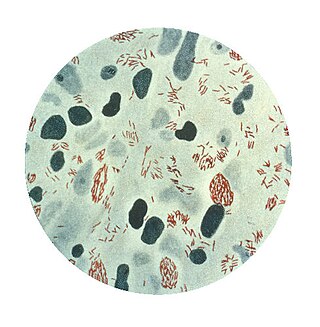
Mycobacterium tuberculosis, also known as Koch's bacillus, is a species of pathogenic bacteria in the family Mycobacteriaceae and the causative agent of tuberculosis. First discovered in 1882 by Robert Koch, M. tuberculosis has an unusual, waxy coating on its cell surface primarily due to the presence of mycolic acid. This coating makes the cells impervious to Gram staining, and as a result, M. tuberculosis can appear weakly Gram-positive. Acid-fast stains such as Ziehl–Neelsen, or fluorescent stains such as auramine are used instead to identify M. tuberculosis with a microscope. The physiology of M. tuberculosis is highly aerobic and requires high levels of oxygen. Primarily a pathogen of the mammalian respiratory system, it infects the lungs. The most frequently used diagnostic methods for tuberculosis are the tuberculin skin test, acid-fast stain, culture, and polymerase chain reaction.

Mycobacterium is a genus of over 190 species in the phylum Actinomycetota, assigned its own family, Mycobacteriaceae. This genus includes pathogens known to cause serious diseases in mammals, including tuberculosis and leprosy in humans. The Greek prefix myco- means 'fungus', alluding to this genus' mold-like colony surfaces. Since this genus has cell walls with Gram-positive and Gram-negative features, acid-fast staining is used to emphasize their resistance to acids, compared to other cell types.

Mycobacterium leprae, is one of the two species of bacteria that cause Hansen’s disease (leprosy), a chronic but curable infectious disease that damages the peripheral nerves and targets the skin, eyes, nose, and muscles.
Mycobacterium caprae is a species of bacteria in the genus Mycobacterium and a member of the Mycobacterium tuberculosis complex. The species is named after the caprines, the organisms from which M. caprae was first isolated. Prior to 2003, the species was referred to as Mycobacterium tuberculosis subsp. caprae. It is also synonymous with the name Mycobacterium bovis subsp. caprae.

Mycobacterium cosmeticum is a rapidly growing mycobacterium that was first isolated from cosmetic patients and sites performing cosmetic procedures.
Mycobacterium diernhoferi is a species of the phylum Actinomycetota, belonging to the genus Mycobacterium.
Mycobacterium haemophilum is a species of the phylum Actinomycetota, belonging to the genus Mycobacterium.
Mycobacterium houstonense is a member of the Mycobacterium fortuitum third biovariant complex. The specific epithet houstonense refers to Houston, Texas, where the first isolate of the M. fortuitum third biovariant (sorbitol-positive) was identified.
Mycobacterium avium complex is a group of mycobacteria comprising Mycobacterium intracellulare and Mycobacterium avium that are commonly grouped because they infect humans together; this group, in turn, is part of the group of nontuberculous mycobacteria. These bacteria cause Mycobacterium avium-intracellulare infections or Mycobacterium avium complex infections in humans. These bacteria are common and are found in fresh and salt water, in household dust and in soil. MAC bacteria usually cause infection in those who are immunocompromised or those with severe lung disease.

Mycobacterium kansasii is a bacterium in the Mycobacterium genus. It is an environmental bacteria that causes opportunistic infections in humans, and is the one of the leading mycobacterial causes of human disease after tuberculosis and leprosy.
Mycobacterium nebraskense is a slow growing, yellow, pigmented mycobacterium that was first isolated from human sputum at the University of Nebraska Medical Center, in Omaha, Nebraska, USA. Mycobacterium species are common causes of pulmonary infections in both humans and animals.
Mycobacterium neworleansense is a member of the Mycobacterium fortuitum third biovariant complex.
Mycobacterium palustre is a slowly growing mycobacterium first isolated from an environmental source in Finland. It is potentially pathogenic, and has been isolated from human and veterinary clinical specimens.
Rapid growing mycobacterium consists of organism of the Mycobacterium fortuitum group and Mycobacterium chelonae/Mycobacterium abscessus group and these usually cause subcutaneous abscesses or cellulitis following trauma in immunocompetent patients.
Mycobacterium lepromatosis is an aerobic, acid-fast bacillus (AFB), and the second known causative agent of Hansen's disease (leprosy). It was discovered in 2008. Analysis of the 16S rRNA gene confirms that the species is distinct from Mycobacterium leprae.
Mycobacterium saskatchewanense is a species of Mycobacterium.
Mycobacterium triplex is a species of Mycobacterium.
Mycobacterium parmense is a species of Mycobacterium.
Mycobacterium arosiense is a newly described species of Mycobacterium. It is a scotochromogen that derives its name from Arosia, the Latin name for the city of Aarhus (Denmark), where the strain was first isolated.




